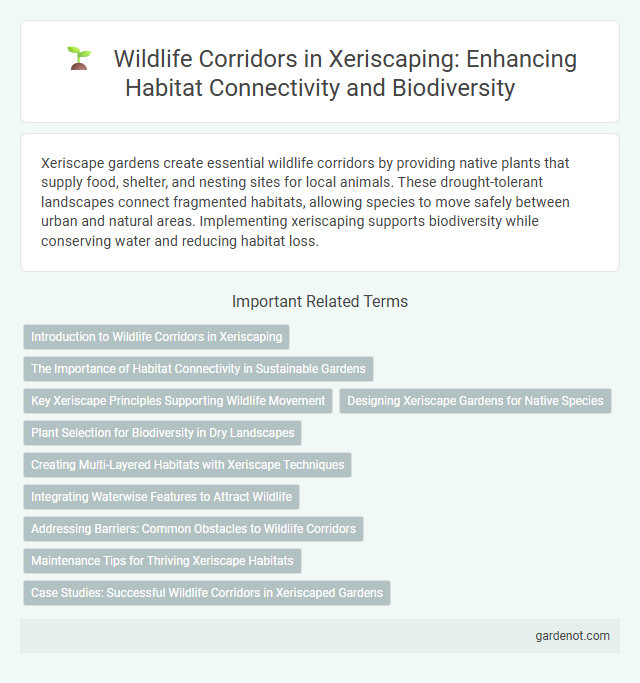Xeriscape gardens create essential wildlife corridors by providing native plants that supply food, shelter, and nesting sites for local animals. These drought-tolerant landscapes connect fragmented habitats, allowing species to move safely between urban and natural areas. Implementing xeriscaping supports biodiversity while conserving water and reducing habitat loss.
Introduction to Wildlife Corridors in Xeriscaping
Wildlife corridors in xeriscaping create essential pathways that connect habitats fragmented by urban development, promoting biodiversity in arid landscapes. These corridors utilize native, drought-tolerant plants to provide food, shelter, and safe passage for local wildlife such as pollinators, birds, and small mammals. Integrating wildlife corridors in xeriscape designs supports ecosystem health while conserving water and reducing landscape maintenance.
The Importance of Habitat Connectivity in Sustainable Gardens
Wildlife corridors in xeriscape gardens enhance habitat connectivity by linking fragmented natural habitats, allowing native species to safely migrate, forage, and reproduce. Maintaining these connections supports biodiversity, promotes ecosystem resilience, and helps sustain pollinators essential for plant health in water-wise landscapes. Integrating habitat corridors in sustainable garden design mitigates the effects of urbanization and climate change on local wildlife populations.
Key Xeriscape Principles Supporting Wildlife Movement
Xeriscape design incorporates native, drought-tolerant plant species that provide essential food and shelter for local wildlife, supporting natural movement along wildlife corridors. Strategic placement of vegetation and water features creates connected habitats, allowing animals to traverse urban areas safely while conserving water. Maintaining diverse plant layers enhances biodiversity and promotes ecological resilience within xeriscaped corridors.
Designing Xeriscape Gardens for Native Species
Designing xeriscape gardens to support wildlife corridors involves selecting native drought-tolerant plants that provide food, shelter, and nesting resources for local species. Incorporating diverse plant layers and maintaining natural water sources improve habitat connectivity and promote biodiversity in arid landscapes. Strategic placement of native shrubs, grasses, and trees enhances movement paths for pollinators, birds, and small mammals in urban and suburban environments.
Plant Selection for Biodiversity in Dry Landscapes
Selecting native, drought-tolerant plants such as desert milkweed, yucca, and mesquite enhances wildlife corridors by providing essential food and shelter for pollinators, birds, and small mammals in xeriscape designs. Incorporating diverse plant species with varying bloom times supports continuous habitat connectivity and biodiversity throughout dry seasons. Strategic plant placement near water sources and migration paths optimizes habitat functionality and promotes ecological balance within arid environments.
Creating Multi-Layered Habitats with Xeriscape Techniques
Creating multi-layered habitats using xeriscape techniques fosters wildlife corridors by integrating drought-tolerant native plants that provide food, shelter, and nesting sites across vertical and horizontal layers. This approach enhances biodiversity by supporting diverse species such as pollinators, birds, and small mammals while conserving water resources in arid landscapes. Xeriscape design elements like rock mulches, native grasses, and layered shrubbery form connected habitats that facilitate safe wildlife movement and ecological resilience.
Integrating Waterwise Features to Attract Wildlife
Incorporating xeriscape principles to create wildlife corridors enhances biodiversity by integrating waterwise features such as native drought-tolerant plants and strategically placed rain gardens. These elements provide essential habitats and reliable water sources, attracting pollinators, birds, and small mammals while conserving water resources. Designing corridors with permeable surfaces and natural water catchments supports ecological connectivity and sustains local wildlife populations in arid environments.
Addressing Barriers: Common Obstacles to Wildlife Corridors
Wildlife corridors face common obstacles such as habitat fragmentation, urban development, and road networks that disrupt animal movement and genetic exchange. Addressing barriers involves designing xeriscape landscapes with native drought-tolerant plants that provide food, shelter, and connectivity without excessive water use. Integrating permeable surfaces and strategic planting helps maintain ecological continuity while conserving water in arid environments.
Maintenance Tips for Thriving Xeriscape Habitats
Regularly clearing invasive species and pruning native plants in xeriscape wildlife corridors promotes healthy growth and biodiversity. Maintaining mulch layers helps retain soil moisture and reduces erosion, essential for sustaining local flora and fauna. Monitoring water usage and adjusting irrigation systems ensures habitats remain supportive without overwatering, balancing conservation with thriving ecosystems.
Case Studies: Successful Wildlife Corridors in Xeriscaped Gardens
Xeriscaped gardens have demonstrated success in creating effective wildlife corridors by integrating native drought-tolerant plants that provide essential habitat and food sources for pollinators, birds, and small mammals. Case studies from arid regions like Arizona and New Mexico reveal that strategic placement of xeriscape vegetation along urban greenways enhances ecological connectivity and supports biodiversity conservation. Research published in the Journal of Arid Environments highlights how these corridors mitigate habitat fragmentation while reducing water consumption in residential landscapes.
Wildlife corridor Infographic

 gardenot.com
gardenot.com